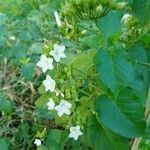Annual twiner; stems pubescent.. Leaf-blade ovate-cordate, up to 4.5(–8) cm. long and 3.5(–5) cm. wide, acuminate at the apex, glabrescent above and sparsely pubescent beneath on the nerves or densely tomentose all over; petiole up to 2.5(–6) cm. long, pubescent.. Flowers several to many in a ± dense cyme; peduncle up to 5.5 cm. long, pubescent; secondarypeduncles and pedicels up to 0.5 cm. long; bracts minute.. Sepals ovate, acute, about 6 mm. long, 2.5–4 mm. wide, pubescent.. Corolla white, pink or yellow, 1 cm. long.. Capsule globose, 5–6 mm. in diameter, straw-coloured.. Seeds dark, subtrigonous, 2.5 mm. long, with very narrow ± indistinct hyaline margins and pale raised roughenings.

